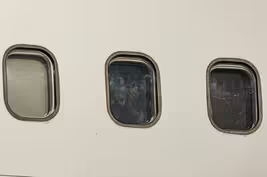
How little of the deep seafloor humans have ever seen
Clip: 5/10/2025 | 5m 15sVideo has Closed Captions
Humans have seen a tiny fraction of the deep sea. Researchers are trying to change that
The deep sea covers about two-thirds of the Earth’s surface, but according to a new study, humans are estimated to have observed less than .001 percent of the deep seafloor — an area roughly the size of Rhode Island. Stephanie Sy speaks with the study’s author, Katy Croff Bell, who is working to change that.
Problems playing video? | Closed Captioning Feedback
Problems playing video? | Closed Captioning Feedback
Major corporate funding for the PBS News Hour is provided by BDO, BNSF, Consumer Cellular, American Cruise Lines, and Raymond James. Funding for the PBS NewsHour Weekend is provided by...

How little of the deep seafloor humans have ever seen
Clip: 5/10/2025 | 5m 15sVideo has Closed Captions
The deep sea covers about two-thirds of the Earth’s surface, but according to a new study, humans are estimated to have observed less than .001 percent of the deep seafloor — an area roughly the size of Rhode Island. Stephanie Sy speaks with the study’s author, Katy Croff Bell, who is working to change that.
Problems playing video? | Closed Captioning Feedback
How to Watch PBS News Hour
PBS News Hour is available to stream on pbs.org and the free PBS App, available on iPhone, Apple TV, Android TV, Android smartphones, Amazon Fire TV, Amazon Fire Tablet, Roku, Samsung Smart TV, and Vizio.
Providing Support for PBS.org
Learn Moreabout PBS online sponsorshipLAURA BARRON-LOPEZ: The deep sea covers about two thirds of the Earth's surface, but only a tiny fraction of it has ever been seen by human eyes.
That's the conclusion of a new study published this week, estimating humans have observed less than 1000th of a percent of the deep sea floor, an area roughly the size of Rhode Island.
The study's author, Katy Croff Bell, is working to change that.
She's a National Geographic explorer and the founder and president of the Ocean Discovery League.
Stephanie Sy has the story.
STAPHANIE SY: Katy Croff Bell, thank you so much for joining the program.
It's so fascinating to think that out of their vast ocean, we've seen basically a drop in the bucket.
I guess I would start by asking you why it matters that so much of the deep ocean has gone unexplored.
KATY CROFF BELL, Ocean Discovery League: Well, the deep sea is the planet's life support system.
It supports plankton in the upper ocean, which produce oxygen that we breathe.
Those plankton also feed fish, which in turn feeds over a billion people worldwide.
The deep sea absorbs heat and carbon dioxide, which moderates our atmosphere so we can live here on Earth.
And increasingly, we're seeing pharmaceuticals that are based on chemical compounds from marine animals.
But despite the numerous benefits from the ocean and the deep ocean, we're impacting the deep sea at an unprecedented.
And we really need to understand those habitats and the processes that are happening down there before we do irreparable harm.
STEPHANIE SY: So 0.001 percent of it has been mapped.
How did you determine how much of it, how little of it had been explored?
KATY CROFF BELL: Well, we actually used two different ways.
One was based on the dive records of three organizations here in the United States who have done thousands of dives over several decades.
And the other way was by taking actual dive track records and their distances along the sea floor.
And so we multiplied those by the amount that you see on the seabed, how fast those vehicles might have gone.
And even with those two independent methods of calculations, we came up with the same order of magnitude, this 0.001 percent of the deep sea, which is about 66 percent of our planet.
STEPHANIE SY: What do you think is down there that we do need to see?
KATY CROFF BELL: Well, that is the mystery, right?
There are so many things that we've found in the last 70 years of exploration.
New habitats, new understandings of life on Earth through the discovery of hydrothermal vents and other sorts of chemosynthetic systems, or life that depends on the chemistry of the water coming up out of the seabed.
So just imagine what's going to be in the 99.999 percent that we haven't explored yet?
STEPHANIE SY: There is a lot of concern out there right now that scientific research writ large is under threat.
Trump administration because of a lot of cuts.
I wonder how you believe your research may be impacted, if at all.
KATY CROFF BELL: We're not quite sure yet specifically.
But right now, of course, as you say there, we're seeing cuts and potential cuts across multiple federal agencies that deal with ocean science and management.
And there's no doubt this will affect scientific research across the country, including for deep sea exploration.
STEPHANIE SY: You talked about some of the potential in the deep sea that could beneficial to humans, such as pharmaceuticals.
Of course, there's also belief that deep sea mining may yield rare earth minerals in the deep sea.
Right.
And President Trump has signed an executive order hoping to explore that more.
What are your thoughts on that?
KATY CROFF BELL: I think that we need more research, but particularly on what the deep ocean ecosystems contain, what those habitats do in the ocean system and global systems, and what the potential impacts of extractive activities like deep sea mining might before we carry out those activities.
Because we know that the deep ocean, you know, there are organisms that live for hundreds and thousands of years that just can't rebound quickly.
So we need to understand what these ecosystems are and what the potential impacts will before we undertake these activities.
STEPHANIE SY: Katy, it's been expensive in the past to launch these deep sea expeditions and I know that your organization is working on making this type of exploration more accessible.
Can you talk about that?
KATY CROFF BELL: It's very expensive to do deep sea exploration and research.
You need a ship and vehicles that can cost millions of dollars and then tens of thousands to a hundred thousand of dollars a day just to operate them.
So that's why we're seeing most of the dives that have happened in the last 70 years concentrated in the waters of the U.S., Japan and New Zealand and undertaken by higher income countries.
So we're working on the development of a new 6,000 meter deep ocean research and imaging system, or DORIS, that's going to cost on the order of only a few thousand dollars.
So bringing down the cost and increasing the usability of these kinds of tools is really going to be a game changer for the deep sea community worldwide and we're really excited about that moving forward.
STEPHANIE SY: That is Katy Croff Bell with the Ocean Discovery League.
Katy, thank you so much for your insights.
KATY CROFF BELL: Thank you for having me, Stephanie.
Hackers leak to press details of Trump deportation flights
Video has Closed Captions
Clip: 5/10/2025 | 4m 31s | Hackers leak to press passenger details of Trump deportation flights (4m 31s)
New film brings Ugandan photographer’s work to life
Video has Closed Captions
Clip: 5/10/2025 | 5m 6s | ‘Memories of Love Returned’ brings Ugandan photographer’s work to life (5m 6s)
Tensions remain high in India and Pakistan after ceasefire
Video has Closed Captions
Clip: 5/10/2025 | 5m 16s | Tensions remain high in India and Pakistan after apparent breaches to ceasefire (5m 16s)
Providing Support for PBS.org
Learn Moreabout PBS online sponsorship
- News and Public Affairs

FRONTLINE is investigative journalism that questions, explains and changes our world.

- News and Public Affairs

Amanpour and Company features conversations with leaders and decision makers.












Support for PBS provided by:
Major corporate funding for the PBS News Hour is provided by BDO, BNSF, Consumer Cellular, American Cruise Lines, and Raymond James. Funding for the PBS NewsHour Weekend is provided by...


